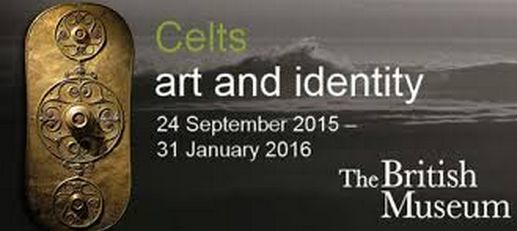Celts: Art & Identity
British Museum
The exhibition is at the Sainsbury Exhibition Gallery, some rather dim and soulless spaces at the back of the museum, it’s billed as the first major exhibition of the Celtic culture in the British Isles in over 40 years.
The name ‘Celts’ does not refer to a single people who can be traced through time, first used by the ancient Greeks as a way to label outsiders, the word ‘Celtic’ was proudly embraced to express a sense of shared ancestry and heritage and has been appropriated over the last 300 years to reflect modern identities in Britain & Ireland and beyond.
The exhibition tells the story of the different peoples who have used or been given the name ‘Celts’ through the stunning art objects that they made. There are displays of intricately decorated jewellery, delicate and personal and evocative of status and style. A collection of highly stylised objects of religious devotion that had often been taken by the Viking raiders and remodel or marked with their owners names, and the romantic decorative arts of the late 19th century which were inspired by the past or modern constructed mythologies.
There is little digital interaction and only two projections of video timelines to flesh out the wider picture but some soundscapes of reconstructed Celtic instruments were of great interest and a collection of resin casts of huge Celtic crosses dominated the second space to great effect. The Gundestrup cauldron, Iron Age, c. 100 BC–AD is breathtakingly perfect, huge, strange, full of history and simply shown in all its beauty. It’s worth the entry fee alone. It is the largest known example of European Iron Age silverwork and the design, mythologies and animals, plants and pagan deities and other compelling beings depicted on the delicate silver is purely spectacular.
A stunning example in the exhibition is a hoard of gold torcs found at Blair Drummond in Stirling in 2009 by a metal detectorist on his very first outing. Four torcs made between 300–100 BC show widespread connections across Iron Age Europe. Two are made from spiralling gold ribbons, a style characteristic of Scotland and Ireland. Another is a style found in south-western France although analysis of the gold suggests it was made locally based on French styles. The final torc is a mixture of Iron Age details with embellishments on the terminals typical of Mediterranean workshops. It shows technological skill, a familiarity with exotic styles, and connections to a craft worker or workshop with the expertise to make such an object. The Blair Drummond find brings together the local and the highly exotic in one hoard. The massive Snettisham hoard is also on display, you could spend all day just checking out the wide variety of Torcs and wondering about the original owners of these phenomenal and often huge pieces of very personal jewellery.
Celtic art continued in Roman Britain, transforming and taking on new influences. The exhibition shows this development and displays objects made using typically Roman forms and technologies, such as multi-coloured enamelling, but decorated in characteristic Celtic motifs. Local people, invaders and settlers coming to Britain from around the Roman Empire used these older abstract designs on new types of objects to express Romano-British identities.
Overall, I felt that although there are some very interesting pieces that the promise of the exhibitions is not met. I learned some things but didn’t really feel that I had experienced much of early Celtic culture. There were plenty of Celtic Christian objects, some with great spiritual resonance and some interesting pretty hotch potch about the generation of the Celtic mythologies in the last few hundred years- but I can see that in a design museum. I felt it completely overlooked Welsh Celtic expression and this may be because the exhibition has been produced in cooperation with the National Museums Scotland but it leaves an odd feeling of something missing as there’s plenty of Irish objects on display.
After leaving the soft and all pervasive Enyaesque sound track being piped evocatively all over the gallery I tripped over to the free Early British Galleries and feasted on the many treasures on display to all and sundry.
It’s never a dull afternoon at the British Museum, the crowds are fascinating, and the space of the Great Court exciting and the shops have some of the silliest merchandise you can imagine. There are a collection of events running alongside Celts, for young people and families and more in-depth analysis of the Celtic culture, you can see and book tickets for them here.
On until January 31 2016
British Museum
Great Russell Street, London WC1B 3DG
Opening times
Monday–Thursday 10.00–17.30pm
Friday 10.00–20.30pm
Saturday–Sunday 09.00–17.30pm
Last entry 80 minutes before closing time
For more information or to book tickets, click here:























You must be logged in to post a comment.